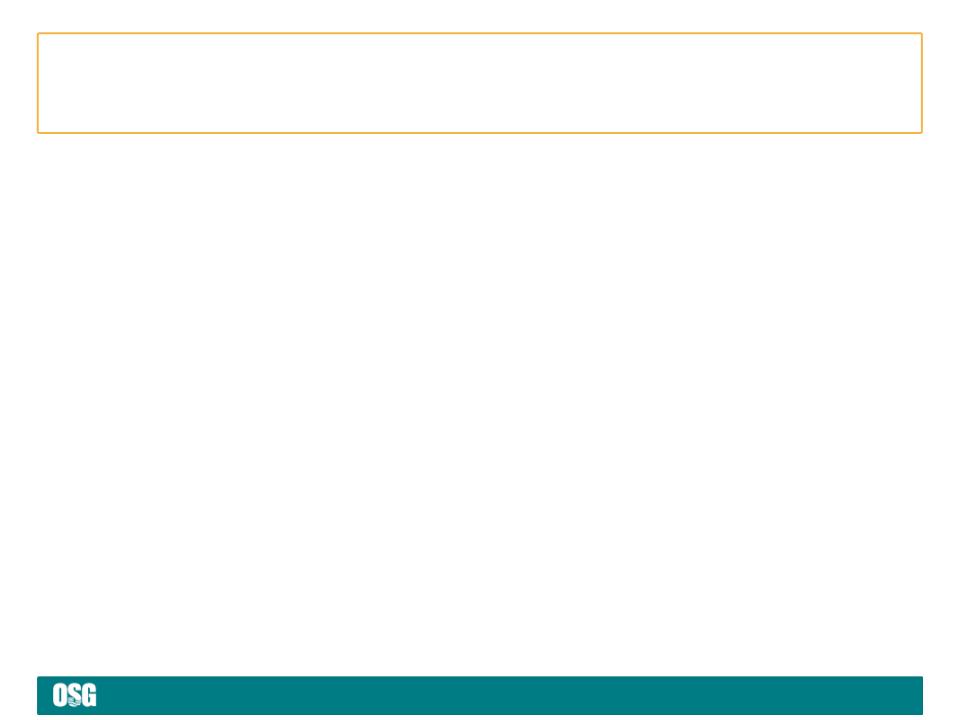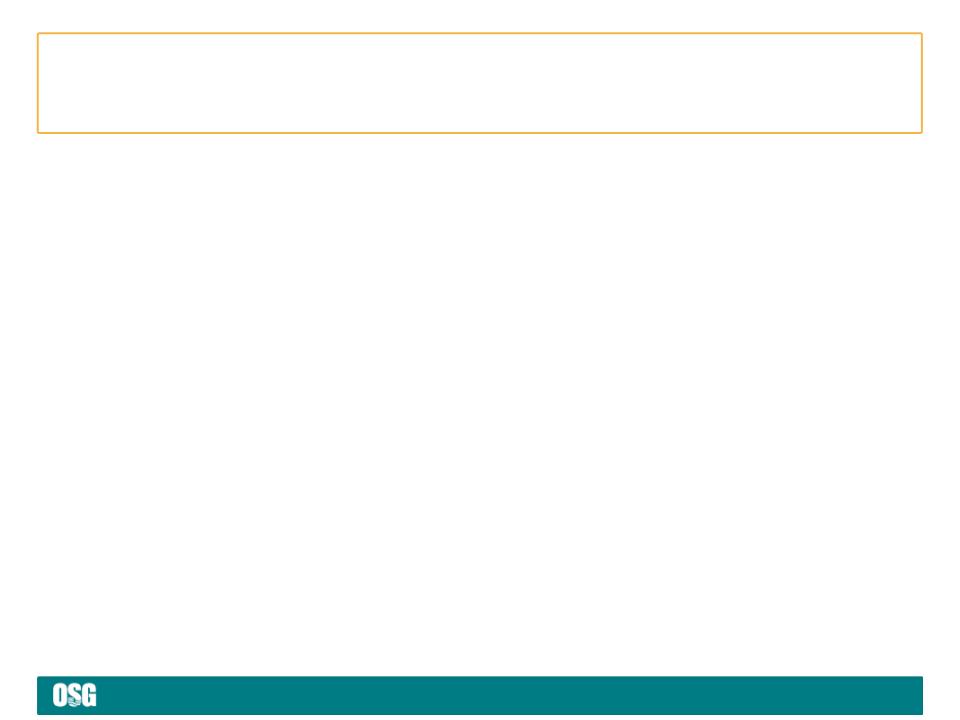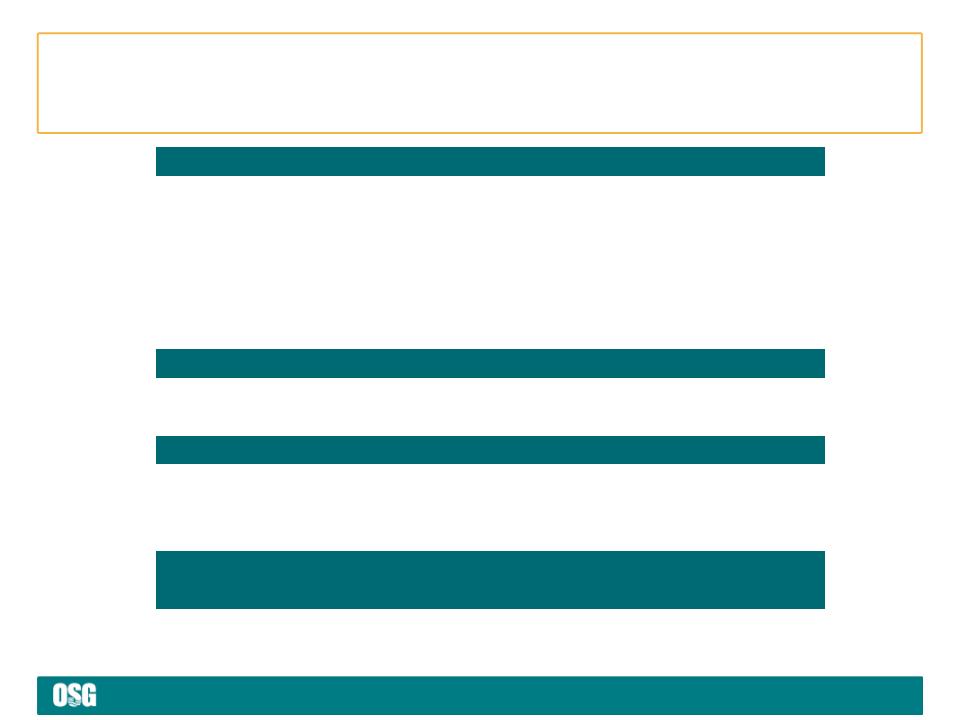Attached files
| file | filename |
|---|---|
| 8-K - OVERSEAS SHIPHOLDING GROUP INC | osg3q8k.htm |
| EX-99.1 - OVERSEAS SHIPHOLDING GROUP INC | osg3q8kex991.htm |
EXHIBIT 99.2

Third Quarter Fiscal 2011 Earnings
Conference Call
Conference Call
November 1, 2011

page 2
Forward-Looking Statements
This presentation contains forward-looking statements regarding the Company's prospects, including the outlook
for tanker and articulated tug barge markets, changing oil trading patterns, anticipated levels and timing of
newbuilding and scrapping, prospects for certain strategic alliances and investments, estimated TCE rates
achieved for the fourth quarter of 2011 and the four quarters of 2012, projected scheduled drydock and off hire
days for the fourth quarter of 2011, projected locked-in charter revenue and locked-in time charter days for the
remaining three months of 2011 and for 2012 through 2015 and thereafter, forecasted 2011 vessel expenses,
charter hire expenses, depreciation and amortization, general and administrative expenses, interest expense,
and levels of equity income and capital expenditures, the profitability in 2011 of certain business units, ability to
access capital markets, including Title XI financing, prospects of OSG’s strategy of being a market leader in the
segments in which it competes and the forecast of world economic activity and oil demand. These statements
are based on certain assumptions made by OSG management based on its experience and perception of
historical trends, current conditions, expected future developments and other factors it believes are appropriate
in the circumstances. Forward-looking statements are subject to a number of risks, uncertainties and
assumptions, many of which are beyond the control of OSG, which may cause actual results to differ materially
from those implied or expressed by the forward-looking statements. Factors, risks and uncertainties that could
cause actual results to differ from the expectations reflected in these forward-looking statements are described
in the Company’s Annual Report for 2010 on Form 10-K and those risks discussed in the other reports OSG files
with the Securities and Exchange Commission.
for tanker and articulated tug barge markets, changing oil trading patterns, anticipated levels and timing of
newbuilding and scrapping, prospects for certain strategic alliances and investments, estimated TCE rates
achieved for the fourth quarter of 2011 and the four quarters of 2012, projected scheduled drydock and off hire
days for the fourth quarter of 2011, projected locked-in charter revenue and locked-in time charter days for the
remaining three months of 2011 and for 2012 through 2015 and thereafter, forecasted 2011 vessel expenses,
charter hire expenses, depreciation and amortization, general and administrative expenses, interest expense,
and levels of equity income and capital expenditures, the profitability in 2011 of certain business units, ability to
access capital markets, including Title XI financing, prospects of OSG’s strategy of being a market leader in the
segments in which it competes and the forecast of world economic activity and oil demand. These statements
are based on certain assumptions made by OSG management based on its experience and perception of
historical trends, current conditions, expected future developments and other factors it believes are appropriate
in the circumstances. Forward-looking statements are subject to a number of risks, uncertainties and
assumptions, many of which are beyond the control of OSG, which may cause actual results to differ materially
from those implied or expressed by the forward-looking statements. Factors, risks and uncertainties that could
cause actual results to differ from the expectations reflected in these forward-looking statements are described
in the Company’s Annual Report for 2010 on Form 10-K and those risks discussed in the other reports OSG files
with the Securities and Exchange Commission.

page 3
Financial Highlights
< Third quarter fiscal 2011 results were driven by continued weakness in our
International Crude markets
International Crude markets
• TCE revenues were $186M, down 11% from $209M in 3Q2010, also below 2Q2011
• Reported net loss of $71.1M or $2.35 per diluted share
• Adjusted net loss of $66.5M or $2.20 per diluted share
< International Crude spot rates weakened further in Q3
• 3Q2011 Crude TCE revenues down 43% vs. 3Q2010 on 3% fewer revenue days
• 3Q2011 realized spot TCEs lower vs. 3Q2010 for all Crude classes
- VLCC 3Q2011 TCE: $10,993/day, - 66% vs. $32,017 in 3Q2010
- Aframax 3Q2011 TCE: $10,322/day, - 33% vs. $15,518/day in 3Q2010
• Markets weakened further into early Q4
< MR spot TCEs in 3Q2011 were comparable to prior year quarter, but time charter
cover has rolled off into weaker spot market
cover has rolled off into weaker spot market
< U.S. Flag - continued improvement in operating income
< Continued containment of vessel expenses and G&A

page 4
Why are the International tanker markets so weak?
< Excess supply remains the issue
• Crude fleet has grown approximately 7% in 2011 YTD September
• Crude orderbook slippage will be 23% in 2011 per Clarksons - we think this will be closer
to 30%
to 30%
< Demand has been resilient in 2011, but major wildcards have all been negative
• Libya’s exit resulted in an expansion of light sweet vs. dirty sour crude spreads
- Asian refineries are substituting cheaper Mideast crudes for West African grades
• Inventory drawdowns increased in Q3 with the August SPR release
- Q3 seasonal demand weakness was compounded by a global inventory draw of 1.1 mil bpd
- OECD inventories are now below their 5-year average
• U.S. growth and oil demand remain sluggish, and long-haul crude imports remain low
• European sovereign debt issues continue to dampen global growth prospects
- There is supposedly a “deal”, but the devil is in the details
< The result of these mounting pressures has been the lowest Crude spot rates seen
in decades, with weakness persisting into early Q4
in decades, with weakness persisting into early Q4

page 5
We think that Q3 will prove to be the trough quarter for this cycle
< Q4 was off to a slow start, as indicated by our forward bookings - we have recently
experienced some rate improvement across our International vessel classes
experienced some rate improvement across our International vessel classes
< U.S. and European refinery maintenance totaled almost 3 million bpd in October
• This has limited crude requirements and reduced product exports
• Refinery maintenance is scheduled for completion by December - with refinery runs
restored, Crude and Product movements will benefit
restored, Crude and Product movements will benefit
- Low clean product inventory levels on U.S. East Coast will draw in imports from Europe
- Diesel arb to Europe should reopen, resulting in additional U.S. Gulf Coast exports
< Is the current rally in Crude rates for real?
• Delays in the Bosporus have driven the recent improvement in Suezmax and Aframax
rates
rates
• The VLCC loading picture in the Arabian Gulf and West Africa has improved - and rates
have risen
have risen
• Refining runs in Asia forecast to increase by 800 kbpd vs 3Q2011
• Increased production of light sweet crudes (Libya, offshore Angola) should stimulate
increased West Africa to Far East movements
increased West Africa to Far East movements
• Still, caution is warranted - the strength of any Winter rally will be tempered by further
inventory drawdowns and fleet growth in Q4
inventory drawdowns and fleet growth in Q4
< But it is too early to call this a Winter Market

page 6
How are we managing OSG through this downturn?
< We continue to pursue our commitment to reducing shoreside G&A and controlling cost at sea
• G&A run rate YTD is below the $95 million stretch target we set for ourselves at the beginning of the year
• Vessel operating expenses are well contained and we continue to maintain superior safety and quality
standards
standards
• We have launched a Company-wide initiative to reduce bunker consumption across the fleet with material
cost savings expected
cost savings expected
< The fleet renewal program is virtually completed this year - minimal forward capital commitments
• Shipyard commitments - $43 mil in 4Q2011, $24 mil in 2012 and $30 mil in 2013
< We have maintained discipline in pursuing growth - it has paid to wait
• With mounting distress for weaker owners, the low in asset values may be near at hand
• The market should present us with opportunities, but we will not chase assets or swing for the fences
< Everyone in the Company remains focused on executing all those things within their control and
their efforts are paying off
their efforts are paying off
< We continue to improve the economics of our chartered-in vessel portfolio by returning ships to
their owners and reducing rates on others
their owners and reducing rates on others
• Time charter-in rates will be reduced by $5,000/day on one VLCC and one Aframax in 1Q/2Q2012
• In 2012 we will redeliver 11.9 VLCCs, Suezmax and Aframax tankers 1
1 Based on OSG’s share in such time charters. Includes certain chartered-in vessels not included in Fleet List.

page 7
How are we managing OSG through this downturn?
Continued improvement in Crude charter-in portfolio economics
Continued improvement in Crude charter-in portfolio economics
< Time charters-in on 11.9 Crude tankers expire in 2012 1
• Average redelivery date - Mid-May 2012
• Charters were arranged in higher rate environments
- Daily rates are higher than current market TCEs, resulting in 2011 operating losses
- Five vessels redelivering in 2012 were chartered-in under sale leaseback arrangements under which
strong vessel prices were monetized
strong vessel prices were monetized
< Depending on our need for capacity, we have the option of redelivering or renewing
at significantly lower daily rates
at significantly lower daily rates
< Excluding the impact of these 2012 redeliveries from 3Q2011 results, Pro forma
P&L would have increased by $12.7 million or $0.42/share - for one quarter 2
P&L would have increased by $12.7 million or $0.42/share - for one quarter 2
< Result: better performance from Crude charter-in fleet in 2012 and beyond
1 Based on OSG’s share in such time charters. Includes certain chartered-in vessels not included in Fleet List. 2 Pro forma analysis reflects base charter hire
component of charter hire expense only and assumes time chartered vessels are either (a) redelivered or (b) renewed at charter-in rate generating zero operating
margin. Use of 3Q2011 realized spot TCEs for Pro Forma P&L analysis is not intended to serve as a forecast of future charter rates.
component of charter hire expense only and assumes time chartered vessels are either (a) redelivered or (b) renewed at charter-in rate generating zero operating
margin. Use of 3Q2011 realized spot TCEs for Pro Forma P&L analysis is not intended to serve as a forecast of future charter rates.

page 8
In Summary
< While we believe that freight rates in our International markets will improve
somewhat in 2012, we will continue to manage the Company as if the current weak
rate environment persists
somewhat in 2012, we will continue to manage the Company as if the current weak
rate environment persists
< Over the last three years we have been successful at controlling costs at sea and
reducing G&A on shore, without sacrificing quality or service. We expect to make
further progress on both fronts in 2012
reducing G&A on shore, without sacrificing quality or service. We expect to make
further progress on both fronts in 2012
< Our U.S. Flag business has been turned around by our team in Tampa and we
expect it to be a reliable contributor to OSG's performance
expect it to be a reliable contributor to OSG's performance
< We believe that the medium term fundamentals for our International Products
business are solid and we expect this unit’s turnaround to be reflected in the
Company's bottom line over the next three years
business are solid and we expect this unit’s turnaround to be reflected in the
Company's bottom line over the next three years
< With our leadership position in International Products and U.S. Flag segments and
our important joint ventures in LNG and FSOs, we are not dependent on crude
tanker rates alone for our turnaround
our important joint ventures in LNG and FSOs, we are not dependent on crude
tanker rates alone for our turnaround
< We have the people, resources, assets and business mix to survive this downturn
and prosper as our markets recover
and prosper as our markets recover

page *
Financial Review
Myles Itkin, CFO

page 10
Financial Review - Income Statement
Reflects impact of lower spot rates, increase in spot
market exposure (from 73% of revenue days in 3Q2010
to 79% in 3Q2011) and higher bunker costs ($16M higher
quarter-over-quarter)
market exposure (from 73% of revenue days in 3Q2010
to 79% in 3Q2011) and higher bunker costs ($16M higher
quarter-over-quarter)
Both FSOs fully employed for quarter and continued to
earn service level bonuses. OSG’s share of FSO JV
income was $1.2M compared with a loss of $2.7M in 2010
and reflects a $0.5M reduction in the mark-to-market loss
associated with the FSO Africa interest rate swaps.
(2011: LNG - $1.9M; ATC - $0.5M)
earn service level bonuses. OSG’s share of FSO JV
income was $1.2M compared with a loss of $2.7M in 2010
and reflects a $0.5M reduction in the mark-to-market loss
associated with the FSO Africa interest rate swaps.
(2011: LNG - $1.9M; ATC - $0.5M)
Reflects growth in U.S. Flag Product Carriers, MRs and
Suezmaxes as well as the return to service of two LR1s
that were undergoing repairs in the 2010 period.
Suezmaxes as well as the return to service of two LR1s
that were undergoing repairs in the 2010 period.
Reflects reductions of $5.7M in compensation costs and
$0.5M in consulting fees; offset by unfavorable F/X rates.
Reductions include benefit of $1.7M arising from market-
related decreases in Company’s liability under certain
unfunded benefit plans
$0.5M in consulting fees; offset by unfavorable F/X rates.
Reductions include benefit of $1.7M arising from market-
related decreases in Company’s liability under certain
unfunded benefit plans
Reflects growth in U.S. Flag operating fleet and return to
service of OSG 209 from layup as well as current quarter
deliveries in Int’l Products fleet
service of OSG 209 from layup as well as current quarter
deliveries in Int’l Products fleet

page 11
Financial Review - Balance Sheet
Reflects $183M drawn under revolving credit facility
and CEXIM facility, offset by $169M in expenditures for
vessels & other fixed assets, $44M in debt repayments
and $40M in dividends paid to shareholders
and CEXIM facility, offset by $169M in expenditures for
vessels & other fixed assets, $44M in debt repayments
and $40M in dividends paid to shareholders
Overseas New Orleans delivered to buyers during
1Q2011; OSG 400 and two tugs held for sale at
September 30, 2011
1Q2011; OSG 400 and two tugs held for sale at
September 30, 2011
Decrease reflects $41M tax refund received in January
2011
2011
1 Short term investments consists of time deposits with maturities greater than 3 months
Includes CIP of $220M for 4 vessels
Includes deferred costs associated with forward start
facility (and other investments designed to offset the
mark-to-market movement in unfunded pension
obligations)
facility (and other investments designed to offset the
mark-to-market movement in unfunded pension
obligations)

page 12
< Strong liquidity and balance
sheet profile
sheet profile
• Cash and availability under the
$1.8B revolving credit facility totals
$0.9B
$1.8B revolving credit facility totals
$0.9B
• Liquidity-adjusted debt 1 to capital =
54.1%
54.1%
• Manageable debt and refinancing
obligations over next two years
obligations over next two years
• Future construction commitments of
$96M
$96M
< Large unsecured asset base
• 70% of Vessel NBV is unsecured
Financial flexibility in distressed markets
|
Covenants on $1.8B facility
(matures in Feb. 2013) 2
|
||
|
Covenant 3Q2011 Capacity
|
||
|
Maximum Leverage 3
< 60% |
47%
|
$1.5B add’l debt
|
|
Minimum Tangible Net Worth
³ $1.2B
|
$2.3B
|
$1.1B in losses
|
|
Minimum
Unencumbered Assets 4
³ 150%
|
211%
|
$0.6B new secured
debt on $0.9B of vessels |
1 Long-term debt reduced by Cash and Equivalents and Short Term Investments. 2 Preliminary figures. 3 Funded indebtedness to total capitalization.
4 Unencumbered tangible assets to unsecured debt; capacity assumes 70% advance ratio.
Debt Repayment and Capital Commitments

page 13
2011 Guidance
§ Estimated vessel expenses $290M to $295M
narrowed range from $290M to $305M
< Time and bareboat charter hire expenses $385M to $390M
narrowed range from $380M to $395M
< Depreciation and amortization $180M to $185M
narrowed range from $180M to $190M
narrowed range from $180M to $190M
< G&A $90M to $95M
updated to reflect impact of lower staffing levels and
declines in stock market valuations on benefit plans
< Equity income of affiliated companies $20M to $25M
< Interest expense $79M to $84M
updated from $80M to $90M due to
delay in Title XI, now expected in 2012
< Capital expenditures
– Drydock costs $45M for full year
(Q4 $17M on 11 vessels)
– Newbuild progress payments, vessel $207M for full year
improvements and capitalized interest (Q4 $44M)

page *
Appendix

page 15
Reconciling Items
Special Items Affecting Net Loss
Set forth below are significant items of income and expense that affected the Company’s results for the three and nine months ended September
30, 2011 and 2010, all of which are typically excluded by securities analysts in their published estimates of the Company’s financial results.
30, 2011 and 2010, all of which are typically excluded by securities analysts in their published estimates of the Company’s financial results.
1 The U.S. Flag asset impairment charges have been tax effected from the pre-tax charge of $25.2 million.

page 16
Reconciling Items (cont’d)
EBITDA
EBITDA represents operating earnings before interest expense and income taxes, plus other income/(expense) and depreciation and
amortization expense. EBITDA is presented to provide investors with meaningful additional information that management uses to monitor ongoing
operating results and evaluate trends over comparative periods. EBITDA should not be considered a substitute for net income / (loss) or cash
flow from operating activities prepared in accordance with accounting principles generally accepted in the United States or as a measure of
profitability or liquidity. While EBITDA is frequently used as a measure of operating results and performance, it is not necessarily comparable to
other similarly titled captions of other companies due to differences in methods of calculation.
amortization expense. EBITDA is presented to provide investors with meaningful additional information that management uses to monitor ongoing
operating results and evaluate trends over comparative periods. EBITDA should not be considered a substitute for net income / (loss) or cash
flow from operating activities prepared in accordance with accounting principles generally accepted in the United States or as a measure of
profitability or liquidity. While EBITDA is frequently used as a measure of operating results and performance, it is not necessarily comparable to
other similarly titled captions of other companies due to differences in methods of calculation.
TCE Revenues

page 17
Fleet Composition - As of October 28, 2011
|
|
Owned
|
Chartered-in
|
Total
|
Newbuild
|
Total
|
|
VLCC
|
10
|
4
|
14
|
1
|
15
|
|
FSO
|
2
|
-
|
2
|
-
|
2
|
|
Suezmax
|
-
|
2
|
2
|
-
|
2
|
|
Aframax
|
6
|
3
|
9
|
2
|
11
|
|
Panamax
|
9
|
-
|
9
|
-
|
9
|
|
Lightering
|
2
|
4
|
6
|
-
|
6
|
|
Total Crude
|
29
|
13
|
42
|
3
|
45
|
|
LR1
|
4
|
2
|
6
|
-
|
6
|
|
MR *
|
16
|
21
|
37
|
1
|
38
|
|
Total Products
|
20
|
23
|
43
|
1
|
44
|
|
Product Carrier
|
2
|
10
|
12
|
-
|
12
|
|
Clean ATB
|
7
|
-
|
7
|
-
|
7
|
|
Lightering ATB
|
3
|
-
|
3
|
-
|
3
|
|
Total U.S. Flag
|
12
|
10
|
22
|
-
|
22
|
|
Total Gas
|
4
|
-
|
4
|
-
|
4
|
|
TOTAL
|
65
|
46
|
111
|
4
|
115
|
* Products MR operating fleet Includes 2 owned U.S. Flag MRs that trade internationally, a car carrier and a chemical tanker.

page 18
Off Hire Schedule
Off Hire and Scheduled Drydock
In addition to regular inspections by OSG personnel, all vessels are subject to periodic drydock, special survey and other scheduled or known
maintenance and repairs. The table below sets forth actual days off hire for the first through third quarters of 2011 and anticipated days off hire
for the above-mentioned events by vessel class for the fourth quarter of 2011.
maintenance and repairs. The table below sets forth actual days off hire for the first through third quarters of 2011 and anticipated days off hire
for the above-mentioned events by vessel class for the fourth quarter of 2011.
1 Includes one time chartered-in vessel that was off-hire for purposes of TCE revenue and charter hire expense until April termination of charter-in
commitment. 2 Includes conversion of Overseas Chinook to shuttle tanker. 3 Includes layup days on vessels sold in 1Q2011.
commitment. 2 Includes conversion of Overseas Chinook to shuttle tanker. 3 Includes layup days on vessels sold in 1Q2011.

page 19
Charter Hire Expense by Segment
For the Quarter Ended September 30, 2011
($ in thousands)
Note: Vessels chartered-in for less than one year are not on the Company’s fleet list.

page 20
Future Revenue $/Days by Segment - As of 9/30/11
Locked-in Time Charter
Days by Segment
Days by Segment
Locked-in Time Charter
Revenue by Segment
Revenue by Segment
($ in 000)
Locked-in
Charter Revenue
Charter Revenue
($ in 000)
Note: Locked-in time charter days for 2011 are as of 9/30/11 and will differ from a more current date used in Appendices 3 and 4 in the quarterly
earnings press release.
earnings press release.

page *
www.osg.com
